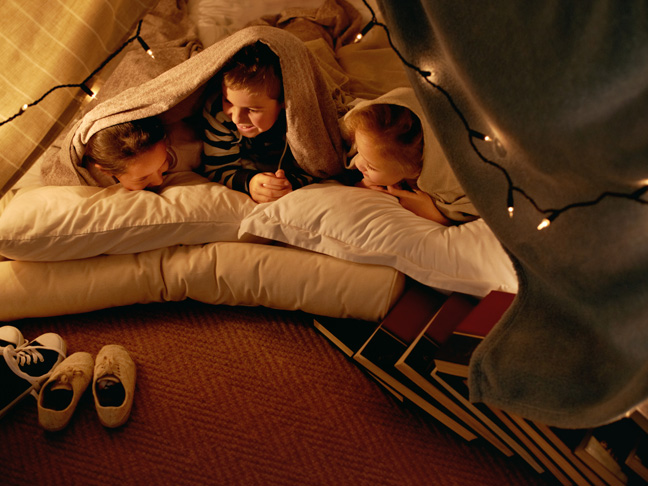Both my husband and I grew up loving Curious George, with all of his mischief, his sense of adventure and, of course, his curiosity. What’s awesome is that our twin boys seem to love the silly monkey as much as we do, and are obsessed with watching the animated series. So you can imagine how excited we were to hear that all nine seasons of Curious George are now on Hulu! One of their favorite episodes is “Camping with Hundley,” when George goes camping, so we weren’t all that surprised when one day, they insisted we get them a tent so that they could go camping, too. After gifting them with an indoor canvas tent for their birthday last year, they immediately launched into a made-up game where they were camping doggies on an adventure. They filled their backpacks with provisions (from their play kitchen), a couple of stuffed animals for company, and set up their tent in the mountains (their bedroom) for a big night under the stars. Since I try to foster my kids’ imagination as best I can, I squeezed into the small tent with them, and noshed on invisible s’mores and hot dogs.
And here’s the thing: While endless rounds of board games can get boring, engaging in imaginative play with your children never gets old, especially when your hear what’s going on in those magical little minds. “So much of a child’s world is logic-based and structured, but when we engage in imaginative play with children, we stimulate that creative, right brain that also helps with problem solving and critical thinking,” says Traci Demuth, Ed.D, founder of Dream AcadeME, an educational program centered on science, technology, engineering, arts, and math (STEAM) in Los Angeles. “Not only that, but when their imagination is going, it actually triggers the parasympathetic nervous system, releasing calming, happy chemicals in their bodies.”
With that in mind, here are some easy ways to escape into imaginary worlds with your kids…
1. Get on a train (or magic car or flying dragon). Around the time my kids were 3, they saw a Curious George episode where he visits a train station and gets his own tour. My boys inevitably became obsessed with train stations, but since the closest they’ve come is a train platform in suburban New York, we’ve had to get creative at home. One way we’re doing that is by imagining a train pulling into their playroom. I play the conductor and when my passengers get on board, ask, “Okay, where are we off to today?” whether it’s the beach, the mountains, or just the ice cream shop. On the way, I ask them to point out what they see out the window, and when we arrive, have them describe the place, along with the smells and sounds. Then, they get to explore all the things that will happen at their chosen destination. When we’re done there, it’s back on the train and on to the next adventure. If your children are older, Demuth recommends expanding on the concept a little further by asking them how you will get to their desired locale–maybe they’ll suggest a unicorn take you there!
2. Play dress up. This is sort of a classic game for kids, but even if their clothes won’t fit you, you should absolutely get in on the fun and don their little hats, their scarves, even their face paint. “When playing dress up with your child, let them lead you,” says child educational psychologist Charlotte Reznick, PhD, founder of Imagery for Kids, and author of The Power of Your Child’s Imagination. “The key thing to remember is that nothing is off limits when it comes to their imaginations. Ask them, ‘What do you want to be? Where do you want to go? What adventure are you dressing for?’ If they get stuck, you can always suggest an idea like the carnival or a magic forest, but whatever the thought, just go with it.”
3. Start a restaurant. Instead of your typical tea party, encourage your kids to start their own eatery. First, help them make a menu of their own choosing. Then, help them set up the table (or tables). Instead of whipping out the plastic toys from your play kitchen though, Demuth recommends encouraging your kids to find objects that can be imagined as food. For example, if you’re going to have pizza on the menu, maybe a Frisbee could be the pie, and you can use checker pieces for pepperoni. “This will stimulate more brain development than plastic toys that don’t require further creative thinking,” she says. You can then all take turns playing server, chef, and patron–one takes the order, one cooks up the delicious pretend dish, and one gets to enjoy the make-believe delicacies.
4. Make shadow puppets. My kids love nothing more than to tell stories in the dark, so shadow puppets are a huge hit at our house. We have one of the premade sets of silhouettes on a stick, with a princess/dragon/knight theme. You can purchase them online at places like Etsy, but it’s even cooler to make your own using heavy black card stock and wooden sticks. You can create whatever creatures your kids desire! Then, set up the flashlight against a bare wall, and let your child play storyteller.
5. Act out their books. Instead of the same-old straight reading of their books, Reznick suggests having them act it out instead. While you’re reading aloud, have them demonstrate what’s happening in the story. It not only engages them in the book, but it allows them to interpret it in their own unique way. You could even change the ending, and have them come up with a creative finale of their own.
*Sponsor note: All nine seasons of Curious George, as well as the animated film Curious George 2: Follow That Monkey, are now streaming, commercial-free, only on Hulu. Visit hulu.com to start your free one- month trial, for a limited time only.
More Imagination Builders:
- Amazing Sensory Play Ideas (& How Sensory Play Benefits Kids)
- 29 Indoor Games Your Kids Will Absolutely Love
- Fun Car Games That Will Entertain Your Kids for Hours
Photo: Getty









